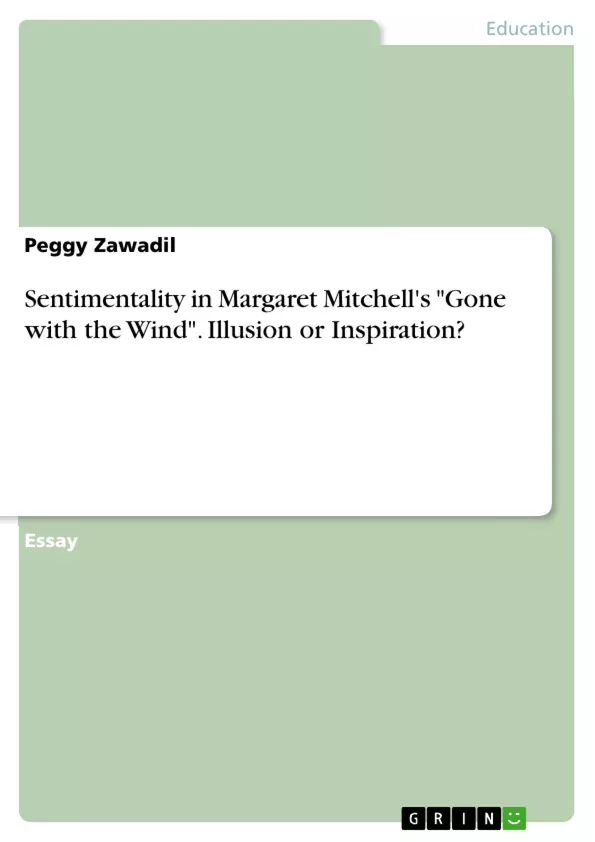Entering the critical dialogue about sentimental books one has to ask if purely descriptive, real and “true” writing can evoke such deep feelings in the reader or if highlighting features in fictional representations and thus creating another “sentimental” reality is what makes writing a great piece of art. Margaret Mitchell’s work "Gone with the wind" takes the reader to the lost era of southern grandeur, plantations and grand festivities.
In describing this time with a sense of longing and nostalgia out of Scarlett O’Hara’s view, Mitchell idealizes this home and the time of slavery and oppression for a part of the population of the United States. But these idealizations serve to evoke feelings of greatness and longing, and thus enable the reader to feel the grief and despair at the loss of it with the female protagonist. It may be true that through idealizing this time a false reality is created and sentimentalists seek consolation by believing these false realities.
Sometimes sentimentalists may want to evoke certain emotions, maintain an illusion and thus entertain highlighted thoughts about an object or a time. But if we rule the commitment of presenting the truth of reality higher than the feelings and pleasures of the audience, the value of aesthetic perfection and escapism, then the higher truth of a great book, to be able to feel your way into the protagonist, is lost. Through evaluating a famous novel by Margaret Mitchell we will find that the terms “great” and “sentimental” are not mutually exclusive but that sentimentality is a necessary feature and a source of inspiration to contribute to a literary masterpiece like “Gone with the wind.”
Inhaltsverzeichnis (Table of Contents)
- Sentimentality - Illusion or Inspiration?
- The evocation of emotional response
- The falsification of the world
- The purpose of a sentimental piece of art
- Sentimental art and the audience
- The influence of a book on a person
- The value of a sentimental book
Zielsetzung und Themenschwerpunkte (Objectives and Key Themes)
This essay aims to examine the concept of sentimentality in literature, using Margaret Mitchell's novel "Gone with the Wind" as a case study. It analyzes the role of sentimentality in evoking emotional responses and its potential to distort reality. The essay also explores the debate surrounding the value of sentimental art and its impact on the reader.
- The nature of sentimentality and its role in literature
- The relationship between emotional response and the perception of reality
- The purpose and value of sentimental art
- The potential impact of sentimental works on readers' beliefs and actions
- The interplay between fictional worlds and the real world
Zusammenfassung der Kapitel (Chapter Summaries)
- The essay opens with a discussion of the nature of sentimentality and its role in literature, exploring the ability of sentimental writing to evoke deep emotions in readers.
- It then examines the arguments of Anthony Savile, who argues that sentimentality relies on a distorted, idealized view of reality, evoking emotional responses based on a false representation of the world.
- The essay further explores Savile's claim that sentimental art can influence readers' beliefs and actions by presenting a distorted reality, potentially leading to false beliefs and inappropriate actions.
- The essay counters these arguments by defining the purpose of sentimental art and its reliance on stylistic and aesthetic devices to evoke specific emotions in the reader.
- It argues that while sentimental art may present a selective or even falsified view of the world, it is not inherently flawed, as aesthetic brilliance and audience engagement can outweigh the pursuit of absolute truth.
Schlüsselwörter (Keywords)
The main keywords and focus topics of this essay include sentimentality, literature, emotional response, reality distortion, artistic value, audience engagement, "Gone with the Wind," Margaret Mitchell, Anthony Savile, idealization, and the potential influence of art on beliefs and actions.
- Quote paper
- Peggy Zawadil (Author), 2013, Sentimentality in Margaret Mitchell's "Gone with the Wind". Illusion or Inspiration?, Munich, GRIN Verlag, https://www.hausarbeiten.de/document/312199


